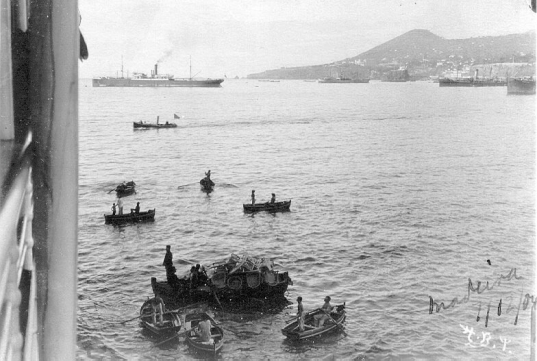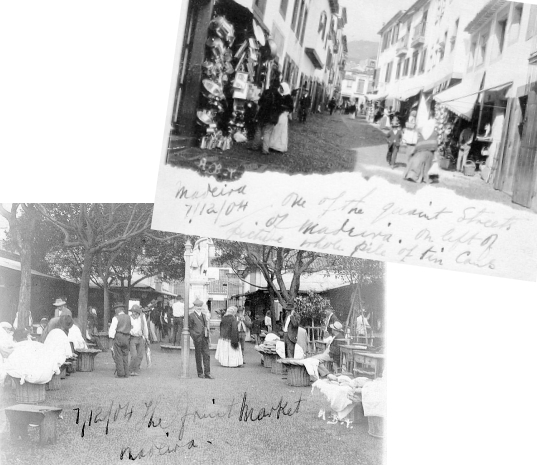Phil Moir's Blog
Welcome to the new Genes Reunited blog!
- We regularly add blogs covering a variety of topics. You can add your own comments at the bottom.
- The Genes Reunited Team will be writing blogs and keeping you up to date with changes happening on the site.
- In the future we hope to have guest bloggers that will be able to give you tips and advice as to how to trace your family history.
- The blogs will have various privacy settings, so that you can choose who you share your blog with.
Official Blogs
Henry Turnbull's voyage to South Africa in 1904
On Saturday the 3rd December 1904, the relatively new RMS "Kenilworth Castle" passenger liner (part of the fleet of Union-Castle Line. See also Union Castle) slipped out of Southampton Docks bound for South Africa. Master of the ship for this voyage was Captain J Morton. The ship was travelling with only half occupancy, some 330 out of a possible 754 passengers spread across the three classes and up to 250 crew. The ship would make one stop in Madeira, the small Portuguese archipelago some 400km east of the Moroccan coast in the North Atlantic, where 15 passengers were due to disembark (and a few likely to join), before proceeding onto Cape Town, Port Elizabeth, East London and then finally 49 days after departing from England, it would reach Durban. Of the 330 passengers who originally boarded in Southampton, the majority, some 258 were due to leave the ship when it first docked in South Africa at Cape Town.

On board, was a 37 year old Edinburgh born man Henry Bachelor Turnbull (below), my great-granduncle, bound along with the majority of passengers for Cape Town, and due never to return to his Scottish homeland again. One of his sister's would later follow, but for this voyage, he travelled alone with no family but certainly not short of company as you will see.

While I have no knowledge of any diary that Henry may have kept or letters he might have written, he did take some wonderful photographs during the voyage, which ended up in his niece's possession. His niece was my grandmother, Ada Turnbull. The photographs have been wonderfully embellished with some of Henry's hand writing, detailing dates, locations and activities, and it is these that really I'd like to share. Extracting from the text that appears on the front and back of the postcard printed photographs, I will attempt to tell Henry's story of the voyage in his words.
"Only 4 days from England on the 7th of December, we drop anchor in the bay of Funchal, the main shipping port on the southern coast of Madeira. Numerous other liners share the bay with us, including at least one German ship. Local diving boys in row boats pull up alongside, trying to sell local wares to the ship crew and passengers."

"The stop in Madeira gives us the opportunity to stretch our legs on dry land, and after a short trip by steam launch we are able to explore the sights around the town of Funchal. The local tourist transport appears to be ox-pulled toboggans. With no wheels, it must be hard work for the ox."

"Although the lifestyle here seems to be more relaxed than back in Edinburgh, the sentry who had been lazily leaning on his rifle, outside the local fort, was only too obliging by commencing to walk up and down while I took this photo."

"A wander around the streets is pleasant, the locals friendly and the markets seem to be the best place to sell wares and gossip."

"The excursion over, we're back on board and steaming on through the equator and toward South Africa. The passengers on board are all very friendly, and on the 13th December we get together on the deck for a sports extravaganza. First up is the "Driving Competition". Here the ladies drive the gentlemen who are blindfolded out and in rows of bottles without knocking the bottles down."

"Now the ladies get a turn for one of the sporting challenges. This is the egg and spoon race. Ladies gather their skirts up, and make a dash for the finish line." (Note. Most of the photographs are initialed with HBT, but from this photograph, the way that Henry has scribbled the B, you can understand how the person recording the original passenger lists may have mistook the middle initial for an "R".)

"The next event is fairly vigorous, and requires quite a bit of agility. Pillow fight on cross bar. Not the easiest task while aboard a steam ship."

"Quite a crowd have gathered to eagerly watch today's events." (Note. From the photo below, there is a plaque on the wall indicating that the activities are occurring in the first class section of the ship, although I am unable to confirm if Henry was travelling first class. Searching Google, I came across the book Cruising written by Marc Mancini, PhD. In respect of the old steam ships, he states "Nowhere on the ship were the two groups allowed to mix". If this were the case we can deduce that Henry was in fact travelling in the first class section.)

"And finally, another event for the ladies. The potato race. A bucket is placed at the start and potatoes at various distances from the start in a straight line. The competitors have to pick up each potato one by one, returning them to the bucket. The first one back to the start with all potatoes wins." (Note. Henry has put an additional note of "Musical Hall ladies" at the foot of the photograph, although I cannot determine exactly what this refers to. Maybe it was the competitors in the race, but I presume they would be passengers and not staff on the ship.)

"While strolling the decks a few days later, I recognise a gentleman relaxing while chatting to a young lady. He is none other than Charles Trigg, one of England's leading jockeys, on his way to Johannesburg to ride in the Xmas handicap. Both Mr Trigg and the young lady are happy to pose for my photo."

"Eventually we arrive in Cape Town, and I say farewell to my fellow passengers. The cold and wet of Scotland now behind, the heat and dry of South Africa and opportunity beckons."
~ ~ The journey ends, but a new adventure begins ~ ~
Earlier today when I started writing up this story, I had assumed the following photographs were part of the same sequence of events and since they were only scans of the front, I knew neither from where they were taken nor who the people were. However, we uncovered the originals, and in fact, my grandmother had appended names and some details on the back. Examining the photos closer, we noticed that Henry had a much more stylised signature by now, the dress sense looks a little more 1920's I think that 1900's, and the photos were printed on different types of postcards. Adding this discovery to some other information that we have gathered this afternoon, I have re-written the final paragraphs (even before posting).
After sometime in South Africa, Henry appears to have moved to a place called Amanzimtoti, about 18 miles south of the city of Durban and 800 miles from Cape Town. Here he either built or acquired The River Gardens Hotel. The photo below I believe shows one of the accommodation buildings.

Searching the Internet gives only a few indications of the existence of the hotel. Although few, they include from an article on the Amanzimtoti River, "At one time it was possible to travel by boat from the town centre to the River Gardens Hotel, which was a popular Sunday activity." and from the website of The Amanzimtoti Wilds Survival Club, "Dion Botha still remembers a wonderful time some 35 years ago when as a child, his parents took him up the River in a rowing boat. The destination was the River Gardens Hotel, where a lovely lunch and music was the highlight of the trip. The River was so crystal clear that he could see the bottom.". Google Maps indicates that the River Gardens Hotel is in Riverside Road, Amanzimtoti 4126, South Africa, but switching to Google Street View, there now appears to be a sign in front of the hotel plot indicating that the site is to be redeveloped into an Eco Estate. I have no idea if any Turnbull's are involved in this project.
Out in the hotel gardens enjoying a nice cup of tea are Henry's wife Fay, and his daughter, Pearl. (Note. I have found no trace of either his wife or daughter living or departing the UK, and wonder whether he met and married Fay in South Africa. A search into South African records will have to follow.)

And finally, a photo of his daughter Pearl strolling along the river bank, where the boats would come up from the city on a Sunday, and drop off their passengers for afternoon tea. I have a couple more photographs of Pearl, one with tennis racquet in hand, the other sitting down with a cat on her lap. The cats apparently were kept at the hotel to keep the snakes away!

The Investigation
One of my first tasks when joining Genes Reunited was to incorporate the Passenger List Departures from 1890 to 1960. Knowing of Henry's photo collection I was particularly keen to confirm the voyage and discover more about it. I've had to wait a while before publishing this blog, but hope you have found it fascinating and also encouraged you to find out more about any travels you're ancestor's may have made,
Since discussing this article with my father, he reminded me of some pictures of my great-grandfather Adam, Henry's brother, boarding a plane bound for South Africa. I never understood the connection, but this trip was to visit Henry and their sister, some 43 years after Henry emigrated. In addition to the photos, we recently made another exciting discovery from a box in the attic, and I will be posting details of that soon!
Passenger Lists
If you know of anyone in your family who left the UK between 1890 and 1960 by ship, then delve into the Passenger Lists are try to locate them. If you find them on a ship, then I recommend exploring further. Enter the ship's name into Google and see what it comes up with. It can be so fascinating. Try the Google Image search to see pictures of the ship or the locations it went to. A handy tip on the image search is to go to the Advanced option and select Black and White images only. This tends to strip out all the recent holiday snaps and promotional pictures, and more likely to give you images from the past. Above all, have fun investigating!
As a warning though, sometimes people did not travel by passenger liner. My maternal grandfather was in the merchant navy, and he was known to get a berth on merchant ships even when not working. These are not included in the regular passenger lists available on Genes.
My Search Notes
1. When searching the passenger lists, I knew the name of my relative, year of birth 1867 and the departure year 1904, so entered these. First search using all the information gave no results. No results
2. I dropped the date of birth, and this gave me one result for Henry Turnbull departing in 1904. Unfortunately this passenger was leaving from Londonderry. This passenger was headed for USA, so I decided to try again. One wrong result
3. The passenger list search looks for exact match of surname (This is how the search is performed at the time of writing. We are currently working on improving the searches across all our records), but for forenames, it looks for any forename beginning wit the letters entered. So I tried just using "H" for the forename. Four possible results. This looked much better. We can discount one, as it is the same result I got from my search at step 2. The first two have initial of "A M H" and "C H". So I can discount them. The last one has initials "H R". Not an exact, but this person is departing from Southampton, so I took a look at the transcription. Got him! Destination is the Cape, and the ship is the Kenilworth Castle. Now for the original image.

Searching Advice
Start with the key information you have. If no results return, try taking information away. Start with location, then dates, then forenames. Try different combinations to get you closer to the facts. Sometimes, when old documents are transcribed, names and/or locations may have different spellings. Genes are working on a more advanced search so that you can find these alternatives quicker or choose to stay with exact matching.
My Blog Notes
While writing this blog, I was constantly searching for additional information on the Internet, and where anything relevant was found, I have provided links. This is vital as it allows the reader to explore your findings further, knowing exactly where information has been found.
Most of the pictures were automatically resized for display on the blog, but some photos/screen-shots have been merged or as in the case of the final original image, been altered to give appearance of ripped paper showing only the relevant portions. This last image also incorporates a zoomed in portion highlighting Henry Turnbull's name. All alterations were done using a free software tool, called GNU Image Manipulation Program (GIMP). This is a Windows based tool that replicates most of the features of the Adobe Photoshop package, and well worth downloading and using if you are comfortable in editing images.
Finally, to explain the tagging. Tags are words or phrases that are associated with a blog, and appear as links under the main title at the top of the page. These are especially useful in linking similar blog posts together, and clicking on a tag will display a summary of the most recent blog posts that have the same tag. For this blog post, I wanted to link the surname of the individual concerned (the forename would have made the tag too limiting), the name of the ship, the topic, and the Genes website relationship. Not all blog posts would have so many links, but in this case I believe it covers the content.
Update: I have been trawling any free South African records I can find, and found a hit when searching for Fay Turnbull at the National Archives of South Africa (NASA) website. Under the database for National Archives Repository (Public Records of former Transvaal Province and its predecessors as well as of magistrates and local authorities) I found details of the death of Harry Batchelor Turnbull in 1950, and his wife is listed as Fay Rachel Turnbull (born Krause). Increases my suspicion that Henry (Harry) met her in South Africa.
Comments
|
Send Message |
Thank you so much for sharing this. My great grandparents emigrated to SA after their marriage in Aug 1904 (James Wilson from Glasgow was a railway clerk). I have been unable to find them on any passenger lists going out, only my gt grandmother and her children returning in 1919 for good after the death of her husband. My gt grandfather's brother (John Wilson) also emigrated to SA and I found him returning to England several times with his wife and daughter until the 1950s.
We have no information in the family, so your blog is lovely to read and gives me a real flavour of what it was like. Thank you! |
|
Send Message |
Thank you for your story. I found it so interesting. I am not tracing any relative but I worked for British and Commonwealth who I believe owned the Union Castle Line so I was very interstd in your story.
Thank you for sharing this. |
|
Send Message |
Phil. Any chance of the passenger lists from 1860 - 1890?
Cheers Mike |
|
Send Message |
Hello Phil ..... My family & I lived just around the corner from The River Gardens Hotel in Amanzimtoti from 1981 - 2002, whence we emigrated to England. The Hotel was demolished in about 2004/5 to make way for townhouses. The last 3 photographs are taken at the hotel. May I ask for a favour please ?
I collect postcards of Victorian/Edwardian Durban & surrounding areas. Would you send me scans of the last 3 photos, please ? They are a wonderful record of the era. Kind Regards |
|
Send Message |
It was great reading the history of your relative, I am at present tracing my uncle who went to Africa in 1904. I have found an R Mason on the "Goorkha " which sailed out of Southampton for the Cape.
I have yet to check this ship out. Robert James Barber Mason as he was called became a manager at the Penhalongha Gold Mines. An experience he writes about to his local vicar in Burwell Cambridgeshire in 1931. It is lovely to have a little piece of history to his life. |

